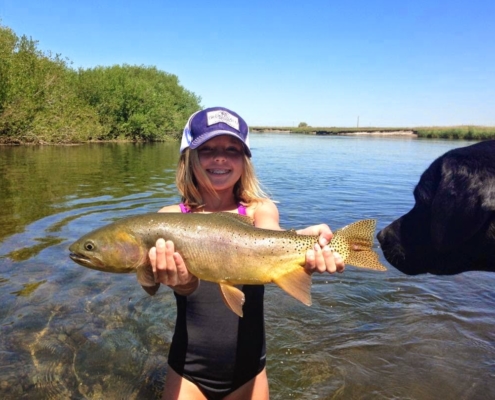A Symbol of our Region – Yellowstone cutthroat trout
The Yellowstone cutthroat trout (Oncorhynchus clarkii bouvieri) is a striking fish, noted for the red slash along the jaw-hence its name. Its body is mostly yellow-brown with darker olive or gray hues on the back, lighter yellow on its sides, and a highly variable black spotting pattern. They are native to the Yellowstone River, Snake River, and Falls River drainages, and like most trout, require cold, clean water in which to live. They spawn in rivers or streams in late April through mid-July. Their favorite foods are aquatic insects— mayflies, stoneflies, caddisflies, etc.—and other small aquatic animals, plus terrestrial insects that fall into the water. They will also eat smaller fish, fish eggs, small rodents, frogs, algae and other plants, and plankton. Because they eat a wide variety of foods, they are a favorite of anglers as they will bite lots of fly and spin patterns.
The Yellowstone Cutthroat Trout (YCT) is an important species in the Greater Yellowstone Ecosystem, upon which many other species depend. They provide an important source of food for an estimated 16 species of birds, and mammals including bears, river otters, and mink. Their range has been reduced by overfishing and habitat destruction due to mining, grazing, and logging. However, the most serious current threats to the subspecies are interbreeding with introduced rainbow trout (resulting in cut bows), the presence of lake trout, which feed heavily on the smaller, less-aggressive cutthroats, and several outbreaks of whirling disease in major spawning tributaries. Occasional drought in the Yellowstone area makes several spawning tributaries run dry in late summer, preventing cutthroat fry from migrating and making them easy prey for predators. These threats have significantly reduced cutthroat populations in the Greater Yellowstone. The YCT has been lost from about 60% of its historic range.
Many of the remaining genetically pure YCT are found within Yellowstone National Park and the South Fork of the Snake and the Teton River, along with their tributaries, are remaining strongholds. The first conservation easement completed by the Land Trust was along Teton Creek, an important spawning tributary. The Land Trust has protected over 1,230 acres along the Teton Creek Corridor including the 847-acre Six Springs Ranch, the home of the Land Trust office. Six Springs is a spring-fed tributary that has been documented by the Land Trust, Friends of the Teton River, and others as one of the most productive spawning tributaries in Teton Valley. The Land Trust has also been a part of protecting and restoring other critical YCT spawning tributaries associated with the Teton River including Fox Creek, Bitch Creek, and Badger Creek.
On the South Fork, work by the Land Trust and the South Fork Conservation Partnership including the Bureau of Land Management, the Nature Conservancy, and the Conservation Fund has protected the majority of the South Fork River Canyon. Altogether, over 20,000 acres and miles of riverfront will remain undeveloped forever. More recently, the South Fork Initiative has been working on restoration and research to improve habitat and water quality to support the fishery.
State and federal wildlife agencies classify YCT as a sensitive species. Efforts continue to be made to support YCT populations, including encouraging anglers to harvest rainbow and lake trout and requiring “catch and release” practices of cutthroats, and protecting and enhancing their habitat and spawning grounds. Fisheries surveys conducted in 2005, 2007, and 2009 show slight improvements in Yellowstone cutthroat trout numbers. Across the region, the recovery in trout populations is a result of successful land conservation and stream habitat restoration efforts by the Land Trust, Friends of the Teton River, Idaho Fish and Game, Teton Soil Conservation District, and many other partners.









